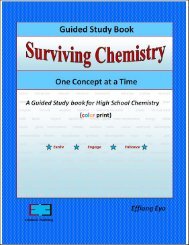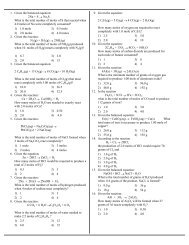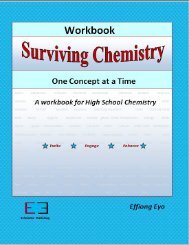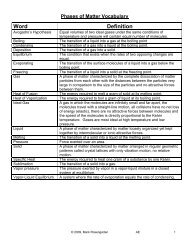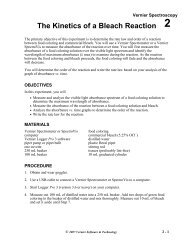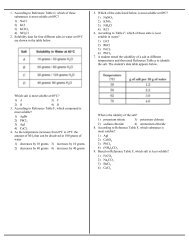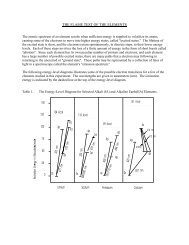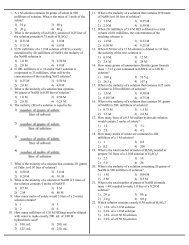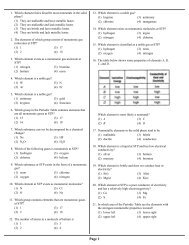Kinetics, Thermodynamics and Equilibrium - Revsworld
Kinetics, Thermodynamics and Equilibrium - Revsworld
Kinetics, Thermodynamics and Equilibrium - Revsworld
You also want an ePaper? Increase the reach of your titles
YUMPU automatically turns print PDFs into web optimized ePapers that Google loves.
3) If ENTHALPY is FAVORED, but ENTROPY is UNFAVORED, then the reaction will only be spontaneous at<br />
LOW temperatures. Above a certain temperature, the reaction will stop being spontaneous.<br />
This reaction has a –∆H. This reaction is EXOTHERMIC, which is favored.<br />
This reaction starts with a solid <strong>and</strong> a gas <strong>and</strong> ends up as a solid. The ENTROPY DECREASES, which is<br />
UNFAVORED.<br />
This reaction will only be spontaneous at HIGH temperatures. Once this reaction gets started, though, watch<br />
outlook how much heat is released! The heat is enough to keep it going, <strong>and</strong> it is extremely difficult to stop this<br />
reaction once started. The heat generated can burn through solid steel plate with little difficulty.<br />
4) If ENTHALPY is UNFAVORED, but ENTROPY is FAVORED, then the reaction will only be spontaneous at<br />
HIGH temperatures. Below a certain temperature, the reaction will stop being spontaneous.<br />
This reaction has a +∆H. This reaction is ENDOTHERMIC, which is UNFAVORED.<br />
This reaction starts out as a solid, but then dissolves into ions that are free to move around. Entropy increases, which<br />
is favored.<br />
This is very typical of dissolving salts in water. Often, the change is endothermic, but the change in entropy is high<br />
enough to overcome that. This is one reason why salts are more soluble at higher temperatures!<br />
Why does water ice melt at temperatures above 0 o C?<br />
H 2 O (s) H 2 O (l)<br />
+6.01 kJ (334 J/g X 18.0 g/mole)<br />
This change has a +∆H (heat of fusion). This is ENDOTHERMIC, which is UNFAVORED.<br />
This change starts with a solid <strong>and</strong> ends up as a gas. The entropy increases, which is FAVORED.<br />
These kinds of changes are spontaneous at HIGH temperatures (see #4, above). This means that this change is<br />
nonspontaneous at temperatures below 0 o C, but from 0 o C on up, this reaction will take place without having to add any<br />
energy. This is why the melting point of water is 0 o C!<br />
Gibbs Free Energy: energy available to do work in a reaction. Nature favors a decrease in free energy.<br />
When you start mowing the lawn, you have a certain amount of energy. As you mow the lawn, your energy reserves<br />
decrease. You have less energy available to do work. You are expending your potential energy (exothermic, favored)<br />
<strong>and</strong> your body temperature is increasing (increase in entropy, favored). Nature therefore favors this change.<br />
The two thermodynamic quantities of enthalpy change (∆H) <strong>and</strong> entropy change (∆S) are related by the Gibbs Free<br />
Energy Equation, ∆G = ∆H - T ∆ S.<br />
Why T ∆ S? Because ∆S is measured in kJ/K <strong>and</strong> you need to cancel out the Kwhich is temperature!<br />
© 2009, Mark Rosengarten AE 16



